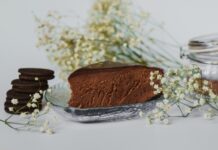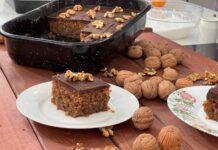![]()
Preparation
30 min
![]()
Baking Time
15 min
![]()
Servings
12
Halva is a sweet , which can be found in various versions in many countries of the Balkans, the Mediterranean and the Middle East. It is not known exactly when entered Greece, halva is likely to have gone to Greek cuisine towards the end of the 12th century. Its name probably comes from the Arabic hulw root (Halva) which means sweet. There are many kinds of halva, among them the most famous are those made of sesame, semigaline, flossaline or parsian, traditional Farsal Halva, Persian and Chestnut Halva.
Ingredient
- 1 cup of semolina thick
- 1 cup of olive oil
- 4 cups of water
- 2 ½ cups of crystal sugar
- 1 lemon peel
- 1 orange peel
- 2 spoonful of cinnamon powder
- 1 orange zest
- 10 pieces of walnuts
Execution
- In a saucepan place the ingredients for the syrup: water, orange peel and lemon, cinnamon powder and sugar.
- Let it boil until you melt the sugar and turn it off.
- In another large saucepan, add the olive oil to a moderate heat and, when it burns, pour the semolina and cinnamon wood and roast with a wooden spoon until it darkens for about 8 minutes.
- Carefully put a very small strainer on the pot of semolina and add the syrup with great care because the mixture is thrown far from the pan. Pass it through the strainer as we pour it. There are two ways to finish our sweet.
- The first one is to continue stirring for 2 minutes and put it in a preheated oven at 180 degrees for about 15 minutes, so it also gets a smell of oven.
- Another option is to continue stirring to moderate heat until it taps off the pot and then drain into small molds and allow it to cool. In both cases serve the sweet with a little cinnamon powder and walnuts.


















